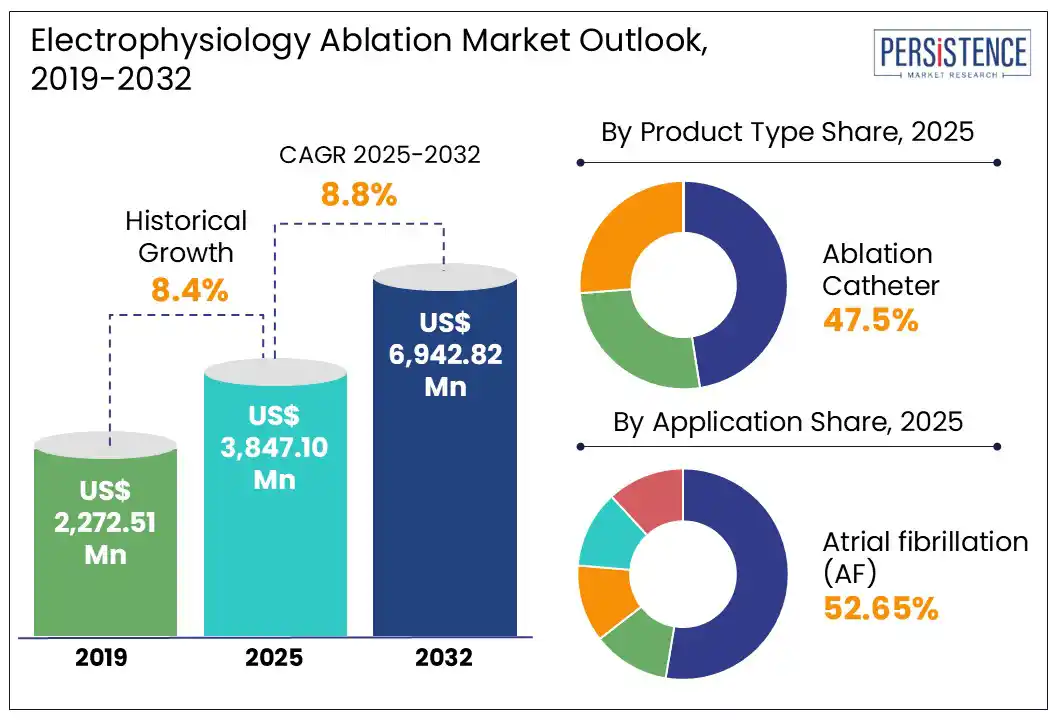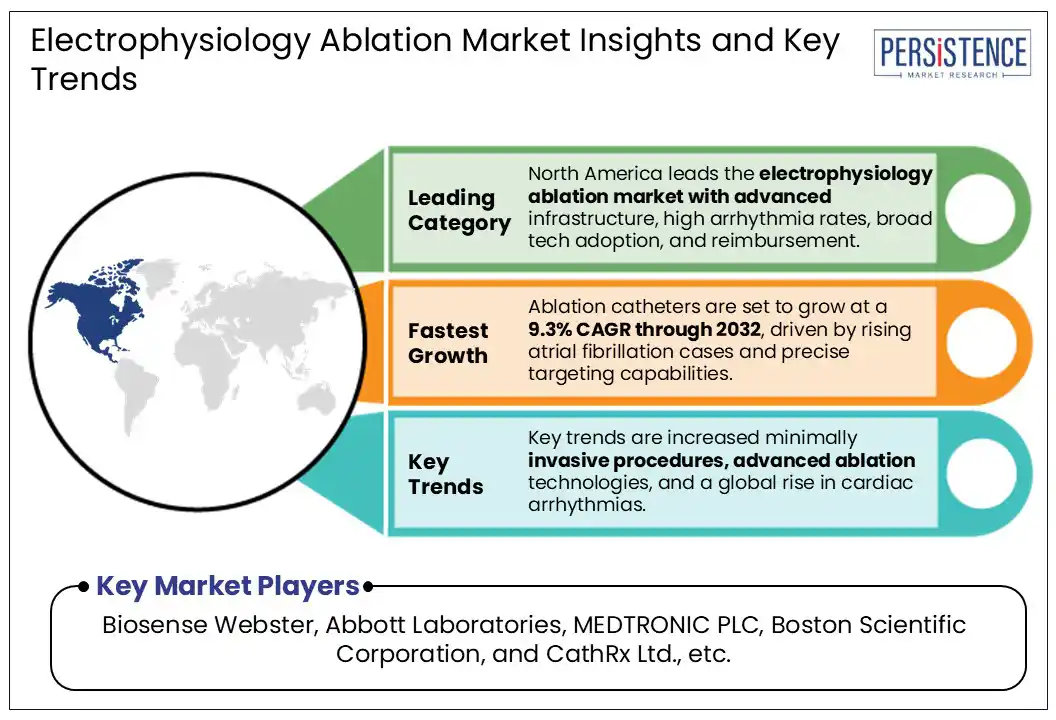ID: PMRREP25474| 210 Pages | 1 Jul 2025 | Format: PDF, Excel, PPT* | Healthcare

The global electrophysiology ablation market size is likely to be valued at US$3,847.1 million in 2025 and is expected to reach US$6,942.8 million by 2032, growing at a CAGR of 8.8% from 2025 to 2032.
The prevalence of Atrial Fibrillation (AF) is increasing, and electrophysiological ablation treatments are becoming more widely used, which has increased the demand for cardiac arrhythmia therapy. Technological improvements in electrophysiology and related cardiac monitoring devices, such as the electroencephalography (EEG) device, are facilitated by the introduction of new electrophysiology ablation variants.
Atrial fibrillation prevalence is rising globally, driving up demand for cardiac ablation procedures and electrophysiology devices. The changing lifestyles of individuals, which significantly raise the risk for atrial fibrillation occurrences, including high blood pressure, attack, cardiac arrest, and others, are one of the main causes of this rise in demand. For instance, the global burden of atrial fibrillation was about 59.7 million in 2019, according to data from the British Cardiovascular Society. By 2030, the Centers for Disease Control & Prevention (CDC) predicts that there will be about 12.1 million cases of atrial fibrillation (AFib) in the U.S. alone.
Electrophysiology ablation device manufacturers can benefit from profitable potential for significant revenue development as a result of growing demand for cost-effective diagnostic options and increasing public awareness of electrophysiology ablation.

Key Industry Highlights:
|
Global Market Attribute |
Key Insights |
|
Electrophysiology Ablation Market Size (2025E) |
US$ 3,847.1 Mn |
|
Market Value Forecast (2032F) |
US$ 6,942.8 Mn |
|
Projected Growth (CAGR 2025 to 2032) |
8.8% |
|
Historical Market Growth (CAGR 2019 to 2024) |
8.4% |
Conventional catheters play a vital role in electrophysiology (EP) procedures, serving multiple functions such as mapping, ablation, and post-procedural assessment. While catheters used in EP cases are primarily designed for single use due to safety, sterility, and regulatory concerns, manufacturers have capitalized on this by positioning catheters as consumable products. This approach not only ensures procedural efficiency but also drives recurring demand, contributing significantly to market revenue. Major cardiac care companies currently dominate the electrophysiology ablation catheter segment. However, the market is witnessing an influx of emerging players offering multifunctional and cost-effective catheter solutions.
These innovations enhance procedural capabilities and reduce overall treatment costs. The increasing clinical reliance on catheters with broader application across different EP stages further strengthens their role in driving the market. As hospitals and clinics adopt these advanced tools, the demand for versatile, single-use catheters are expected to grow steadily, offering substantial opportunities for both existing and new market participants.
Recalled products have an impact on the market as a whole, and manufacturers are most likely to suffer as they could have an indirect or direct effect on their company. Product recalls cause a disruption in net sales. Aside from that, other market leaders or participants fill the gap left by recalled products.
The electrophysiology ablation market is witnessing significant growth due to a clinical shift away from antiarrhythmic drugs as the first-line treatment for arrhythmias, particularly atrial fibrillation (AF). Traditionally, antiarrhythmic medications were widely prescribed to manage irregular heart rhythms. However, concerns regarding limited long-term efficacy and adverse effects impact their clinical utility. For instance, Sanofi-Aventis’ Dronedarone, a novel antiarrhythmic, was withdrawn due to increased creatinine levels and serious side effects, especially in patients with compromised cardiac function.
This evolving treatment landscape has opened a substantial opportunity for electrophysiological ablation procedures, which offer higher success rates and fewer systemic side effects. As more physicians adopt ablation therapy over pharmacological approaches, hospitals and cardiac centers are expanding their electrophysiology programs. This, in turn, is increasing the demand for ablation-related technologies such as RF and cryoablation catheters, 3D mapping systems, and advanced diagnostic tools. Medical device companies stand to benefit by offering next-generation ablation solutions that meet the growing clinical need for safe, effective, and minimally invasive arrhythmia management.
The ablation catheters segment accounted for the highest share of around 47.0% of the product segment by the end of 2024. The majority of arrhythmias can be treated safely and effectively with this product, with cure rates of 80–90%. The product has the power to enhance the quality of life and prevent arrhythmia symptoms, including fatigue, weakness, and shortness of breath. Ablation catheters are the most profitable and widely used devices on the market because of their life-saving benefits.
In 2024, atrial fibrillation accounted for the largest revenue share in the electrophysiology ablation market, contributing approximately 52.7%. This condition remains the most prevalent form of arrhythmia and carries a significant risk of stroke and blood clots. According to the British Heart Foundation, around 1.62 million people in the UK were living with atrial fibrillation as of March 2024. Additionally, it is estimated that about 270,000 individuals aged 65 and above in the UK have undiagnosed atrial fibrillation. The widespread occurrence of this condition has played a key role in driving the dominance of this segment.
In response to this growing burden, recent advancements have introduced mobile applications designed for arrhythmia management, enabling patients to stay connected with healthcare providers. Furthermore, hospitals and clinical centers are increasingly integrating arrhythmia-focused care into their standard treatment protocols.

In 2024, North America held the largest share of the global electrophysiology devices market, accounting for 39.4% of total revenue. This dominance is mainly due to the high number of cardiovascular disease cases, well-developed healthcare infrastructure, and the strong presence of major market players in the region. The growing number of surgical procedures and increasing awareness about the benefits of minimally invasive treatments are also boosting market growth.
The U.S. electrophysiology ablation market alone contributed over 86% of North America's revenue in this market and is expected to see the fastest growth in the coming years. Factors driving this growth in the U.S. include a large patient population, availability of advanced medical facilities, and frequent new product launches. These developments make the country a key contributor to the regional market. Together, these trends suggest strong future demand for electrophysiology devices across North America, particularly in the United States.
The electrophysiology ablation market in Europe showed strong performance, driven by increased demand for minimally invasive cardiac procedures and rising awareness of arrhythmia management. Across the region, healthcare systems are adapting to outpatient-based care models, which have led to higher adoption of catheter-based ablation procedures. Technological advances and wider access to diagnostic tools have further supported market growth.
Germany remained the leading contributor within Europe, with a significant market share supported by a high burden of cardiac diseases and extensive access to specialized treatment centers. The demand for ablation catheters continues to rise in Germany due to the growing number of patients requiring intervention for arrhythmias. The United Kingdom also contributed notably to the regional market. An increasing incidence of heart-related conditions such as atrial fibrillation and ischemic heart disease, along with government initiatives for early diagnosis and treatment, is pushing demand for EP ablation solutions.
France is emerging as a fast-growing market. Contributing factors include lifestyle-related cardiac risk factors, greater investment in cardiac care infrastructure, and the presence of skilled healthcare professionals. Overall, Europe’s EP ablation market is on an upward trend, supported by improved access to treatment, continuous innovation, and regional efforts to reduce cardiovascular disease burden.
The Asia Pacific electrophysiology ablation market is witnessing rapid growth, driven by increasing cardiovascular disease prevalence, improved healthcare access, and rising awareness about advanced cardiac treatments. Countries such as China, India, and Japan are leading the market due to large patient populations and expanding healthcare infrastructure. China shows strong demand, supported by government investments and local manufacturing.
India is a rapidly emerging market, fueled by the growing burden of arrhythmias and improved availability of EP technologies in urban hospitals. Japan has a high adoption rate of minimally invasive procedures and robust reimbursement systems. The region is poised to witness a significant growth in the coming years due to technological advancements, favorable government policies, and increased investment from global medical device companies.
Heart rhythm therapy has made significant advancements and innovations during the last few years. The ecosystem for future product advancements in the electrophysiological ablation industry will be shaped by ongoing research. Market leaders are concentrating on expanding their product portfolio to sharpen their customer insight skills.
The global electrophysiology ablation market size is estimated to increase from US$ 3,847.1 million in 2025 to US$ 6,942.8 million in 2032.
Rising arrhythmia prevalence, aging population, and preference for minimally invasive procedures are driving demand for advanced electrophysiology ablation technologies.
The market is projected to record a CAGR of 8.8% during the forecast period from 2025 to 2032.
Biosense Webster, Abbott Laboratories, MEDTRONIC PLC, Boston Scientific Corporation, CathRx Ltd., and Others.
Expanding treatment adoption in emerging markets and innovation in catheter design create strong commercial opportunities for ablation device manufacturers.
|
Report Attribute |
Details |
|
Historical Data/Actuals |
2019 - 2024 |
|
Forecast Period |
2025 - 2032 |
|
Market Analysis Units |
Value: US$ Mn, Volume: As applicable |
|
Geographical Coverage |
|
|
Segmental Coverage |
|
|
Competitive Analysis |
|
|
Report Highlights |
|
|
Customization and Pricing |
Available upon request |
By Product Type
By Application
By End-User
By Region
Delivery Timelines
For more information on this report and its delivery timelines please get in touch with our sales team.
About Author